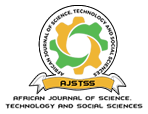Phonological analysis of Kĩtigania borrowed words from the Maa Language: An optimality approach
DOI:
https://doi.org/10.58506/ajstss.v1i1.58Keywords:
Phonological analysis - Kitigania, Maa language, Markedness, Structural well-formednessAbstract
The notion of loanwords in languages that are in a contact situation is a phenomenon that is very common and unavoidable. For languages of the world, language change is remorseless, inevitable and ceaseless. This is because every day there are new innovations, change of ideas and emerging technologies that force language to be dynamic so as to keep up with the changes. Even as languages borrow, linguistic borrowing which entails loan word adaptation is an overwhelmingly phonological process. This phonological analysis has not been adequately examined in Kĩtigania borrowing from the Maa language whereby both are in contact situation. That is why this article did a phonological analysis of Kĩtigania borrowed words from the Maa language using the Optimality Theory’s markedness and faithfulness constraints. Data used in this article was collected using descriptive research design. Purposive sampling was done to select ten Maa and ten Kĩtigania speakers who were neither too old nor too young. These respondents had control over their articulators. Then interviews were conducted with all the respondents to elicit words borrowed to Kĩtigania and their meanings. The findings revealed that when borrowed segments are adapted to Kĩtigania, they undergo sound modification so that those adapted are faithful to those in the source language (Maa Language) and they are present in the Kĩtigania inventory. However, the loans undergo structure modification so as to fit the Kĩtigania syllabic structure. Nevertheless, markedness dominated faithfulness in Kĩtigania borrowing. Therefore, this article concludes that similarity of sounds between two languages brought by shared features as well as a language’s inventory and syllabic structure play a big role in Kĩtigania borrowing. In addition, different repair strategies which result to phonological processes are employed in Kĩtigania borrowing. They include; deletion, substitution and voicing or weakening.
Downloads
Published
Versions
- 2022-10-01 (3)
- 2022-10-01 (2)
- 2022-09-26 (1)


